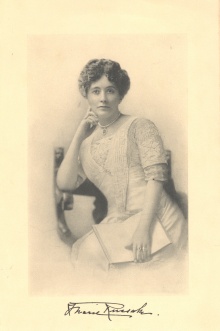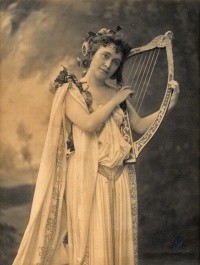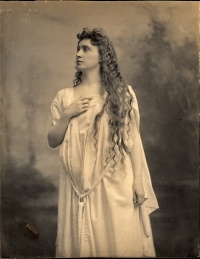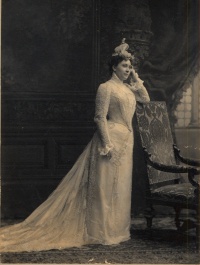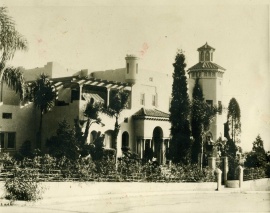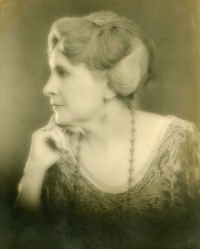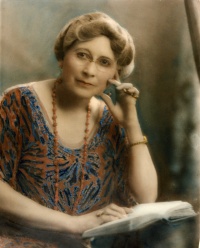Marie Russak Hotchener
ARTICLE UNDER CONSTRUCTION
ARTICLE UNDER CONSTRUCTION
Marie Russak Hotchener (October 7, 1865 - March 4, 1945) an opera singer, architect, writer, editor, and secretary to H. S. Olcott and Annie Besant, was a prominent leader of the Theosophical Society (Adyar). She died in 1945 in Hollywood, California.
Early years and operatic career
Mary Ellen (or Marie Elaine) Barnard was born on October 7, 1865 in the small town of Four Corners, located in Butte County, northern California. She was the daughter of Judge Allen Mather Barnard of San Francisco and Sarah Ann McIntosh. She was educated in Mills College, Oakland, California. Even as a young girl Marie had a lovely singing voice. The famous Spanish soprano Adelina Patti urged her to consider opera, and after study in Europe, Marie sang leading roles in Italian, French and German opera companies under the stage name "Marie Barna."
She was married to Justin Harvey Smith (1857-1930), a publisher, in Boston, 1892, but the marriage soon ended in divorce. In 1899 she married banker Frank Russak (1858-1914).
After meeting the President-Founder of the Theosophical Society, Colonel Olcott in London in 1906, she gave up her singing career to become his secretary. Among the musical engagements she declined was an an invitation from Cosima Wagner to perform at the Bayreuth Festival.[1]
Theosophical work
Miss Barnard traveled with Colonel Olcott to India in 1906. While on shipboard, he met with a serious accident from which never recovered. She was present at his deathbed, where she witnessed the visit by the Masters to the dying president on February 17, 1907.
For the next four years she stayed in India acting as Annie Besant's secretary. In 1909 Miss Barnard was appointed to be an international lecturer, and traveled with the president on extensive tours, speaking in fluent French, German, and Italian.
"In addition to her natural eloquence and charm as lecturer and writer, she was a deep student of psychology, having studied with such scientists as Bernheim, Liebault and Charcot, attending their clinics in Nancy and at the Salpetrière in Paris. This scientific training enabled her to speak with authority before metaphysical audiences and student groups.[2]
Marie Russak helped found the Krotona Colony, in 1912. With Mrs. Besant, she co-founded the Order of the Temple of the Rosy Cross, and designed a number of houses for Theosophists.
Life in Hollywood
In Hollywood, Marie turned her creativity to architecture. She designed Moorcrest, the magnificent home of Charlie Chaplin at 6147 Temple Hill Drive, in a combination of Moorish and Mission styles. She and Henry built their own house next door at 6137 Temple Hill Drive. It was a similarly majestic building with five bedrooms, four bathrooms, and a tower like a minaret. That house served as the base of operation in 1930 when Marie Hotchener edited The Theosophist. After Annie Besant decided to take the editorial tasks back to Adyar, she gave Marie and Henry permission to publish another Theosophical periodical called World Theosophy.
Later years
Mrs. Hotchener was a member of the Besant Lodge in Hollywood, California.[3]
She passed away on March 4, 1945.
Writings
Mrs. Hotchener wrote numerous articles for Theosophical journals. The Union Index of Theosophical Periodicals lists 17 articles under the name Marie Russak, 52 under Marie R Hotchener, 10 under the name Marie Russak Hotchener, and more under other variations of her name.
Notes
Online resources
Articles
- Marie Barnard Russak Hotchener at Theosopedia
- The Diva of Krotona at Doves Today
- Marie Barnard at Fourth Millennium
- Marie Russak at Wikipedia
- Marie Russak Hotchener and Moorcrest: The Theosophist Opera Singer and Her Architectural Fantasia at Under the Hollywood Sign
- About The "Torre del Moro" designed by Marie Russak
